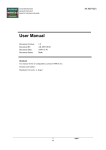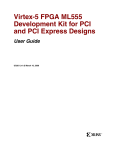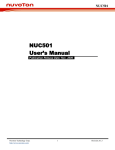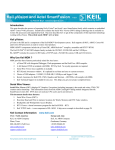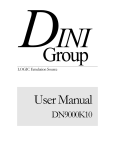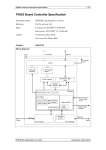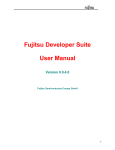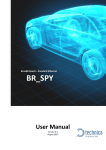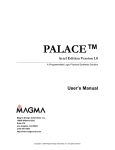Download Actel Firmware Usermanual
Transcript
usermanual 1-25 Actel Firmware Usermanual Document Name: actel_usermanual.doc Document Revision: 0.2 Firmware Revision: 1.3 Date: Created on 8/9/2006 9:15:00 AM Author: Johan Alme (JA), Ketil Røed (KR) [email protected] [email protected] Last Saved By: Johan Alme, May 8, 2007 actel_usermanual.doc Johan Alme & Ketil Røed usermanual 2-25 ACTEL FIRMWARE USERMANUAL ....................................................................1 1 DOCUMENT CONTROL...................................................................................3 1.1 1.2 1.3 1.4 REVISION HISTORY ..........................................................................................3 REFERENCES ...................................................................................................3 CVS................................................................................................................3 DOWNLOADS...................................................................................................3 2 OVERVIEW.........................................................................................................4 3 ACTEL FIRMWARE GLOBAL REGISTERS................................................5 3.1 3.2 3.3 3.4 4 RCU-SH AND DCS-RCU OPERATION MODES...........................................7 4.1 4.2 4.3 5 COMMAND REGISTER STRUCTURE ..................................................................6 STATUS REGISTER STRUCTURE ........................................................................7 ERROR REGISTER STRUCTURE .........................................................................7 VERSION NUMBER REGISTER STRUCTURE ........................................................7 MEMORY MAPPED MODE .................................................................................8 FLASH MODE .................................................................................................10 SELECTMAP MODE .......................................................................................11 CONFIGURATION OF THE EXTERNAL FLASH DEVICE ....................11 5.1 USING THE SOFTWARE TOOLS .......................................................................11 5.1.1 Prepare for initial configuration & scrubbing ....................................12 5.1.2 Prepare for frame by frame readback and verification .......................13 6 ADVANCED USER ...........................................................................................15 6.1 SOFTWARE TOOLS .........................................................................................15 6.1.1 Rcuflashprog -The RCU Flashprogramer ...........................................15 6.1.2 Framegen – The framegenerator .........................................................16 6.1.3 Framever..............................................................................................17 6.2 HOW TO READ OUT A SINGLE FRAME FROM THE SELECTMAP INTERFACE ....17 6.3 ARCHITECTURE OF EXTERNAL FLASH DEVICE ..............................................21 6.3.1 Setting up Flash device for initial configuration and scrubbing .........22 6.4 PREREQUISITES OF ACTIVE PARTIAL RECONFIGURATION .............................25 actel_usermanual.doc Johan Alme & Ketil Røed usermanual 3-25 1 Document control 1.1 Revision history Rev. 0.1 0.2 0.3 0.4 0.5 Rev. date 02.11.06 08.04.07 Document status First draft Small error corrections on address mapping Responsible JA/KR JA 1.2 References Ref. No. 1 Doc. Name. Actel specification.doc Rev / Rev date 0.5/09.08.06 2 Ug012.pdf V4.0/March 05 3 Ds083.pdf V4.5/Oct 05 4 MX29LV640BT-BB-1.2.pdf V1.2/Sep 95 5 ProASICPlus_DS.pdf V5.0/Aug 05 Title Digital module requirement specification Virtex-II Pro and Virtex-II pro X User Guide Virtex-II Pro and Virtex-II pro X Platfrom FPGAs: Complete Data Sheet MX29LV640BT/BB 64M-BIT [8Mx8/4Mx16] single voltage 3V Only Flash Memory Data Sheet ProASICPLUS Flash Family FPGAs Data Sheet 1.3 CVS This document and the complete project are checked in to the ALICE CVS database at the University of Bergen. Url: http://web.ift.uib.no/kjekscgi-bin/viewcvs.cgi/vhdlcvs/ Module name is rcu_cpld. 1.4 Downloads Visit http://web.ift.uib.no/~kjeks/wiki for future updates on this document, programming files and detailed documentation. actel_usermanual.doc Johan Alme & Ketil Røed usermanual 4-25 2 Overview The solution on the RCU boards consists of a flash-based Actel FPGA that communicates with the SelectMAP Interface on the Xilinx Virtex-II pro, and an onboard Flash Memory. The Actel FPGA has a communication interface upwards to the DCS board. All needed configuration files for the Xilinx are stored on the Flash Memory. Due to the limited access to the Actel for later firmware updates, the main focus in the development of the firmware has been robustness. Thus as much functionality as practical possible is handed over to the DCS board. actel_usermanual.doc Johan Alme & Ketil Røed usermanual 5-25 3 Actel firmware global registers Register name Address Type Description Command Size (bit) 1 0xB000 W Command_SM 12 0xB002 W Actel_Reset Status Error Version_Number Input_Data 1 12 8 16 16 0xB003 0xB100 0xB101 0xB102 0xB103 T R R R RW RB_ErrCnt 16 0xB104 R RB_Err_FrameNumber 12 0xB105 R RB_FrameNumber 12 0xB106 R RB_numOfCycles 16 0xB107 R Stop power up Code 4 0xB112 W Flash_Interface _Memory SelectMAP_Interface _Memory 512x16 0xB200 – 0xB3FF 0xB400 – 0xB5FF RW Writing to this register triggers a command execution. See Table 3.2 for available commands Writing to this register triggers a command execution for the SelectMAP. See Table 3.3 for available commands Asynch reset to Actel device Status Register. Table 3.4 Error Register. Table 3.5 Firmware version: Table 3.6 Data to write to Actel, decided by command how it should be interpreted Number of Errors found by readback and verification of Xilinx Configuration Memory Last frame number with error (as given by the sequence stored in the Flash memory) Last frame being verified (as given by the sequence stored in the Flash memory) Number of times a complete Frame by Frame readback (all frames) has been done. Writing X”A” to this register prevents the Actel from trying to automatically configure the Xilinx if sm_done is low RAM block used for Flash Communication RAM block used for SelectMAP Communication 512x16 1 RW Table 3.1: Externally accessible registers. Registers 0xb104 through 0xb107 are referred to as information registers. 1 Legend: W=write, R=read, T= write trigger (not physical registers) actel_usermanual.doc Johan Alme & Ketil Røed usermanual 6-25 3.1 Command Register Structure The normal operation is command based. This means that most functionality is controlled by command registers that is made available for the DCS board. In addition an input data register is used as a configuration register for some of the commands. Command CLEAR_ERROR Value 0x1 Data register (0xB103) Not Used CLEAR_STAT INIT_CONFIG 0x2 0x4 Not Used Not Used SCRUB SCRUB_CONT 0x10 0x20 RBFRAME 0x100 Not Used Num of times to run. If zero then run continuously until abort. Not Used RBFRAME_CONT 0x200 ABORT 0x8000 Num of times to run. If zero then run continuously until abort. Not Used Description Clears error register, and brings FW out of an illegal state. Must be done if error has occurred. Clears status register and counters Initial configuration of Xilinx from Flash Reconfigures Xilinx one time. Scrub Continuously from Flash Read back single frame from Xilinx and clear error if found. Continuously read back Xilinx and clear error if found Aborts ongoing operation Table 3.2: Command Register Codes (0xB000). Used for executing the main tasks of the Actel firmware. Command SM Value INIT_XIL 0x1 Data register (0xb103) Not Used STARTUP_XIL WRITE_XIL 0x2 0x4 Not Used Data to be written READ_XIL 0x8 ABORT_XIL 0x10 Number of 16 bit words to read. If this register is 0, only 1 read op is performed. Not Used Description Do init procedure of Xilinx. Will erase the content of the Xilinx configuration memory. Do startup procedure of Xilinx Write a 16 bit word to SelectMAP IF Issue a read command of SelectMAP IF. (Only effective if certain write commands been issued first) Issue abort sequence Table 3.3: Command_SM Register Codes (0xB002). The SelectMAP Command register is used for executing atomic tasks on the SelectMAP bus. actel_usermanual.doc Johan Alme & Ketil Røed usermanual 7-25 3.2 Status register structure Name Value of the Stop power up code register (0xb112) Null pointer in flash Bit index 11:8 7 Busy 6 Not used Smap busy 5 4 (Last) Active code 3:0 Description 0xA: Automatic configuration of Xilinx is deactivated 0: Flash contains a pointer value 1: Flash contains no pointer value 0: Configuration controller ready to received command 1: Configuration controller is busy with ongoing task/command NA 0: SelectMAP interface module ready 1: SelectMAP interface busy Contains the last task carried out by the configuration controller 0xA: Initial configuration 0xB: Scrubbing 0xC: Scrubbing continous 0xD: Read back frame and verify 0xE: Read back frame and verify continuous Table 3.4: Status register (0xB100). 3.3 Error register structure Name SelectMAP RAM parity error Bit index 7 Flash RAM parity error 6 Not used Smap unknown command 5:3 2 Smap busy not asserted 1 Smap Done failed 0 Description 0: No parity error 1: Parity error detected in SelectMAP RAM 0: No parity error 1: Parity error detected in Flash RAM NA 0: Legal command 1: Unknown command issued to Smap interface 0: No errors 1: Busy on SelectMAP interface was not actived 0: Done detected after configuration of Xilinx 1: Failed to detect Done from SelectMAP interface. Table 3.5: Error register (0xB101) 3.4 Version number register structure Name Major number Minor number Bit index 15:8 7:0 Description For firmware version v1.03 major number this register will contain the value 0x103 Table 3.6: Version number register (0xB103) 4 Rcu-sh and DCS-RCU operation modes The RCU Shell is a small command-line software for communicating with the firmware on the RCU motherboard, that is the Xilinx Virtex-II and Actel firmware. It is started by simply typing 'rcu-sh' at the command-line. This will bring you to the actel_usermanual.doc Johan Alme & Ketil Røed usermanual 8-25 shell mode, where different types of commands can be executed. Issuing a command in the rcu-sh software can be done either by writing rcu-sh <command> in the dcs board linux terminal prompt, or by first starting the rcu-sh software and then write the <command>. The RCU motherboard can be operated in three different modes. 1. Memory mapped mode 2. SelectMAP mode 3. Flash mode The default mode is memory mapped mode, which gives you direct memory access of the registers in the FPGAs on the RCU motherboard. Figure 4-1: Sketch showing a logical model of the three modes.From left to right Flash mode, SelectMAP mode and Mempry mapped mode (normal operation). In Memory Mapped Mode the RCU Flash Memory is read-only. Flash mode gives the dcs board direct control of the flash memory on the RCU motherboard, while SelectMAP mode gives the dcs board direct control over the SelectMAP interface of the Xilinx Virtex-II on the RCU motherboard. 4.1 Memory mapped mode Normal operation in memory mapped mode assumes that the flash is setup with correct pointer information and configuration files and frames. If the on board Flash device contains no data or incorrect data, section 5 provides more information on how to proceed. Table 4.1 lists the general commands used to write to and read from register and memory locations in the Actel firmware. actel_usermanual.doc Johan Alme & Ketil Røed usermanual Option Get help on commands: Single write Multiple write Single read Multiple read 9-25 Command help w<rite> 0x[address] 0x[data] w<rite> 0x[address] <num> 0x[data] num = number of sequental addresses to write the given data to r<ead> 0x[address] r<ead> 0x[address] [num] num = number of sequental addresses to read Table 4.1: General rcu-sh commands The most frequent used commands during normal operation are: Reading the status, error and other important registers • By reading back register 0xb100 through 0xb107 r 0xb100 8 Disabling the automatic configuration feature • By writing 0xa to the stop power up register w 0xb112 0xa Clearing error and status registers • Clearing error register • Clearing status register (0xb100 & 0xb104-0xb107) w 0xb000 0x1 w 0xb000 0x2 and information registers Complete initial configuration of the Xilinx FPGA • By single command from DCS board • On power up of the board • If Xilinx is not configured and the stop code 0xa is not written to the stop power up code register 0xb112. w 0xb000 0x4 Active Partial Reconfiguration (Scrubbing) of the complete configuration memory in the Xilinx. It is issued by a single command from the DCS board and runs either as: w 0xb000 0x10 • a single reconfiguration w 0xb000 0x20 • continuously running a given number of cycles or until an abort is issued The given number of cycles [num] until an abort must first be written to the data register. If the data register stores the value 0 the operation will run continuously until an abort is issued. w 0xb103 0x[num] Frame by frame readback and verification, and reconfiguration of a frame if an error is discovered. There are two possible ways of operation • • stepping through one single frame at the time by a DCS command, making it possible to read the contents of the memories from DCS board for more thorough error logging and handling continuously running a given number of cycles or until an abort is issued w 0xb000 0x100 w 0xb000 0x200 The given number of cycles [num] until an abort must first be written to the data register. If the data register stores the value 0 the operation will run continuously until an abort is issued. w 0xb103 0x[num] actel_usermanual.doc Johan Alme & Ketil Røed usermanual 10-25 Delete the configuration memory of the Xilix Virtex-II FPGA • this command activates the prog_b line of the SelectMAP interface, thereby deleting the content of the configuration memory of the Xilinx. w 0xb002 0x0x1 This only works when 0xa is written to the stop power up register 0xb112 to disable automatic reconfiguration of the Xilinx. Some additional commands exists which are related to communication with the SelectMAP interface. These commands are recommended use for advanced users only. Option Issue startup procedure of Xilinx Write a 16 bit word to the SelectMAP IF by first writing to the data register (0xb103) and then issuing the command Issue a read from the SelectMAP IF by first writing the number of words to read in the data register (0xb103). If the data register contains 0, only 1 word is read Command w 0xb002 0x2 w 0xb103 0x[data] w 0xb002 0x4 The result will be placed in the actel internal SelectMAP user memory (RAM) and can be read out by issuing the command Issue the SelectMAP abort sequence r 0xb400 [num] [num]= number of words to read w 0xb113 0x[num] w 0xb002 0x8 W 0xb002 0x10 Table 4.2: Advanced commands related to the SelectMAP interface 4.2 Flash mode In this mode the firmware on the DCS board gets direct access to the Flash device control and data bus interface. The following options are available: Option Enable flash mode Disable flash mode Get help on commands: Write to single address in flash: Write a file from a start address in the flash: Erase complete flash: Erase sector: Read single address from flash Verify content memory of the actel_usermanual.doc flash Command flash enable flash disable flash help flash write 0x[address] 0x[data] [num] num = number of sequental addresses to write the given data to flash write [-s] 0x[address] file [size] -s = byteswap enabled size = number of 16 bit words to write to the flash from beginning of file. flash erase all flash erase sec 0x[sector address] flash read 0x[address] [num] num = number of sequental address to read from the given address. flash verify 0x[address] file Verifies that the content of the flash from the given address matches the content of the given file. Johan Alme & Ketil Røed usermanual 11-25 Table 4.3: Available rcu-sh commands in FLASH mode The command interface to the Flash device is equal to normal operation of rcu-sh only typing the word flash in front of the command. When writing to the external flash device it is important to remember that you can only write zeros – not ones – to the flash memory. This means that if something wrong is written, then one must erase the sector and rewrite all what is written into it. It is also very important to not overwrite anything in the areas of the programming files, as this can cause damage to the Xilinx when configuring it. 4.3 SelectMAP mode In this mode the firmware on the DCS board gets direct access to the SelectMAP interface. For the moment this mode only supports initial configuration using the following command sequence: 1. rcu-sh sm enable 2. cat <bitfile.bit> > /dev/virtex/ 3. rcu-sh sm disable 5 Configuration of the External Flash Device The on board Flash memory device plays a key role in the proper operation of the Actel firmware. Without a correct configuration of this Flash memory the Actel firmware will not be able to carry out the main tasks of initial configuration, scrubbing and frame by frame readback and verification. The external flash device can be configured using a combination of the rcu-sh software and/or other dedicated software tools. Section 5.1 describes the approach to configure the external flash device using the dedicated software tools. Section 6.1 gives a detailed description of the software tools. 5.1 Using the software tools There are 2 available software tools for frame generation and flash programming: • Framegen – reads back frame data via the SelectMAP interface and generates the correct frame files to be programmed to the flash • Rcuflashprog – programs the initial configuration file, the scrubbing file and the frame files to the correct locations in the flash The rcuflashprog is used together with a configuration file called flashconf.txt. This file contains different parameters that can be set according to which operation that will be carried out. That is, one can choose to program the configuration file, the scrubbing file, or the frame files separately, or a combination of these files. This is done by setting the different enabling parameters connected to the respective files to either true or false. actel_usermanual.doc Johan Alme & Ketil Røed usermanual 12-25 5.1.1 Prepare for initial configuration & scrubbing Software tools Rcuflashprog Configuration files Flashconf.txt Rcu.bit (or other confirguration file) Rcu_apr.bit (or other scrubbing file) Comments The default setting is to erase the full content of the flash Enable the init program file and scrubbing file settings and disable the frame file settings in the flashconf.txt file: enable_icfile = true(enable programming of initial configurationfile) enable_scfile = true (enable programming of scrubbing file) enable_frfiles = false (disable programming of frame files) The path and filename have default settings and must be changed if other paths or filenames are used. It is however not recommended to change any other default values such as for instance the start addresses. This may lead to incorrect configuration of the flash device and possible failure in the firmware operation. ----------RCU Flashprogramer config file-------------------#enable erase enable_erase = true #init program file enable_icfile = true path_icfile = /mnt/dcsshare/ name_icfile = rcu.bit startaddr_icfile = 8000h #scrubbing file enable_scfile = true path_scfile = /mnt/dscshare/ name_scfile = rcu_apr.bit startaddr_scfile = 60000h #frame file enable_frfiles = false path_frfiles = /mnt/dcsshare/ name_rawframefile = frame$.hex name_readframefile = r_frame$.hex name_writeframefile = w_frame$.hex framesfile = frames.txt startaddr_frfiles = 100000h frame_offset = 2h header_size_read = 1Bh footer_size_read = 0Bh ------------------------------------------------------------ Save changes and type the command: “./rcuflashprog flashconf.txt” in the command prompt. The file(s) will now be programmed to the flash. To configure the Xilinx Virtex-II with the new initial configuration file type the command: “rcu-sh w 0xb000 0x4” in the command prompt. See section 6 for information on the scrubbing feature of the firmware. actel_usermanual.doc Johan Alme & Ketil Røed usermanual 13-25 5.1.2 Prepare for frame by frame readback and verification Software tools Framegen Rcuflashprog Configuration files frames.txt read_header.txt read_footer.txt write_header.txt write_footer.txt Flashconf.txt Rcu.bit (or other configuration file)* Rcu_apr.bit (or other scrubbing file)* frames.txt frame$.hex r_frame$.hex w_frame$.hex Comments The Xilinx virtex-II must be configured with the proper firmware The default setting is to erase the full content of the flash. *Optional: the programming of the initial configuration file or scrubbing file can be disabled. 5.1.2.1 Framegen In order to prepare for frame by frame readback and verification the different frame files must be generated. This is carried out by the framegen software tool. It reads out the frames specified in the frames.txt file from the Xilinx Virtex-II. The frames are stored as hex files in 3 different groups: • original frame data: frame$.hex • read frame data: r_frame$.hex (read_header.txt & read_footer.txt are added) • write fram data: w_frame$.hex (read_header.txt & read_footer.txt are added) See section 6.1.2 for more information about the configuration files. Before the framegen software is started make sure that the Xilinx Virtex-II is configured with the correct firmware. It is also important to check if you can communicate with the Actel Device and the Flash Device. If you get errors when doing this, the Xilinx DCS interface is not correct. Start the framegen software with the command: "./framegen frames.txt write_footer.txt" read_header.txt read_footer.txt write_header.txt Depending on the number of frames to be generated (specified in frames.txt) this operation may take several minutes. 5.1.2.2 Rcuflashprog Enable the frame file settings in the flashconf.txt file: enable_frfiles = true As for initial configuration and scrubbing use default values unless other paths and filenames are used. actel_usermanual.doc Johan Alme & Ketil Røed usermanual 14-25 Save changes and type the command: “./rcuflashprog flashconf.txt” in the command prompt. The file(s) will now be programmed to the flash. To configure the Xilinx Virtex-II with the new initial configuration file type the command: “rcu-sh w 0xb000 0x4” in the command prompt. The Xilinx will now be programmed. See section 6 for information on the frame by frame readback and verification feature of the firmware. actel_usermanual.doc Johan Alme & Ketil Røed usermanual 15-25 6 Advanced User 6.1 Software tools The Actel firmware gives the 3 options of initial configuration, scrubbing and frame by frame readback and verification. Operation Initial configuration Scrubbing Frame by frame R&V Need file(s) in flash Full configuration bit file Software tool Rcu-sh Rcuflashprog* Scrubbing configuration bit Rcu-sh file Rcuflashprog* Rcubitfileprog Write frame files Framegen* Read frame files Rcuflashprog* framever Figure 6-1: The table lists the different software tools that can be used to configure the external flash device. 6.1.1 Rcuflashprog -The RCU Flashprogramer -----------------------------------------------The RCU Flash Programer is a Tool for programing the RCU Flash memory. It is configurable through a config file which can be specified as a parameter. "./rcuflashprog flashconf.txt" An example of the configuration file can be found at the end of this README file. For the initial config: the initial configurationfile and the path to the initial configurationfile have to be set. Also the startaddress for the initial configuration. For the scrubbing: The scrubbingfile and the path to the scrubbingfile have to be set, also the the start address for the scrubbing. For the flash programing of the frames: The path for the framefiles has to be set, also there have to be all the frames specified in the framesfile. the three "name_" variables define the filename of the framefiles. The $ is therefore replaced with "X.Y.Z" where X is the Block, Y is the Major and Z the Minornumber. The startaddress has to be defined, also the size of the readheader and the readfooter. actel_usermanual.doc Johan Alme & Ketil Røed usermanual 16-25 ----------RCU Flashprogramer config file-------------------#init program file enable_icfile = true path_icfile = /mnt/kjekspc4/dominik/bin/rcuflashprog/ name_icfile = initconfig.bit startaddr_icfile = 0h #scrubbing file enable_scfile = true path_scfile = /mnt/kjekspc4/dominik/bin/rcuflashprog/ name_scfile = scrubbing.bit startaddr_scfile = 60000h #frame file enable_frfiles = true path_frfiles = /mnt/kjekspc4/dominik/bin/rcuflashprog/ name_rawframefile = frame$.hex name_readframefile = r_frame$.hex name_writeframefile = w_frame$.hex framesfile = frames.txt startaddr_frfiles = 100000h frame_offset = 2h header_size_read = 1Bh footer_size_read = 0Bh ------------------------------------------------------------ 6.1.2 Framegen – The framegenerator In order to prepare for frame by frame readback and verification the different frame files must be generated. This is carried out by framegen software tool. The Framegenerator is a Tool for reading out frames from Xilinx configuration memory. To run it 5 input files are needed: • Frames file (i.e. frames.txt) • Read header file (i.e. read_header.txt) • Read footer file (i.e. read_footer.txt) • Write header file (i.e. write_header.txt) • Write footer file (i.e. write_footer.txt) These files have to be given to the program on startup as parameters, i.e.: "./framegen frames.txt read_header.txt read_footer.txt write_header.txt write_footer.txt" The frames file contains the framenumbers coded in Block, Major and Minornumber. The syntax in the frames file is like this: "Block;Major;Minor;" i.e.: actel_usermanual.doc Johan Alme & Ketil Røed usermanual 17-25 0;5;3; 0;5;4; The header and footer files contain the commands to be executed before/after reading of a frame. Also this data is included in the created readback files. The addresses of the frames have to be inserted as variables into this file ("frame_addr31_16" and "frame_addr15_0"). The proper addresses for the frame will be inserted here by the program. For every frame it creates three files: • one file with the raw readback data • one file with the read header before the data and the read footer after the data • one file with the write header before the data and the write footer after the data 6.1.3 Framever The framever is used to run a more thorough readback and verification operation from the DCS board. The tool makes it possible to the location of the actually SEUs within the individual frames. The tool will not be discussed in this version of the user manual. 6.2 How to read out a single frame from the SelectMAP interface A full frame read back via the SelectMAP interface carry out by first writing a sequence of header data to the SelectMAP interface, then reading back the frame content before closing with a sequence of footer data. The header and footer data are special commands for preparing the SelectMAP interface for a frame read back FFFFFFFF AA995566 30008001 00000007 30016001 00000069 30008001 00000004 30002001 $frameaddr 28006000 480000D4 20000000 20000000 # # # # # # # # # # # # # # Sync word Type 1 header: Write 1 word to cmd-register Reset CRC Type 1 header: Write 1 word to frame-length register Set frame length Type 1 header: Write 1 word to cmd-register Read configuration data command Write frame address command Frame address (ex: clb – major 5 – minor 3) Type 1 header: Read from Configuration Out reg. (FDRO) Type 2 header: Read 212 words from FDRO NOOPs to flush the register Table 6.1: Read frame header. This table is based on table 4-37 in the Virtex-II FPGA user guide (Ref No. 2), without the commands related to the shutdown. actel_usermanual.doc Johan Alme & Ketil Røed usermanual 30008001 00000007 30008001 0000000D 20000000 20000000 18-25 # # # # # # Type 1 header: Write 1 word to cmd-register Reset CRC Type 1 header: Write 1 word to cmd-register de synch interface NOOPs to flush the register Table 6.2: Read frame footer. This table is based on table 4-37 in the Virtex-II FPGA user guide (Ref No. 2), without the commands related to the shutdown. In between the header and footer the read back frame file is stored. The data must be ordered following a Big Endean 16 bit system. The frames have the following address composition: 31:27 00000 BA 26:25 XX MJA 24:17 XXXXXXXX MNA 16:9 XXXXXXXX Byte number 8:0 000000000 Table 6.3: Virtex-II Pro frame address composition See the Virtex-II FPGA user guide (Ref No. 2) for more information on addressing the different frames and reading and writing frame data. In order to write data to the SelectMAP interface the following rcu-sh commands are use: W 0xb103 0x[data] (write data to actel data register) W 0xb002 0x4 (issue a write of data to the SelectMAP IF) In Table 6.4 an rcu-sh script example is given for reading out a single frame. This example is for a CLB (BA: 00) with MJA 3 and MNA 2 which gives the address 0x00060400. actel_usermanual.doc Johan Alme & Ketil Røed usermanual 19-25 #write header commands w 0xb103 0xffff w 0xb002 0x4 w 0xb103 0xffff w 0xb002 0x4 w 0xb103 0xaa99 w 0xb002 0x4 w 0xb103 0x5566 w 0xb002 0x4 w 0xb103 0x3000 w 0xb002 0x4 w 0xb103 0x8001 w 0xb002 0x4 w 0xb103 0x0000 w 0xb002 0x4 w 0xb103 0x0007 w 0xb002 0x4 w 0xb103 0x3001 w 0xb002 0x4 w 0xb103 0x6001 w 0xb002 0x4 w 0xb103 0x0000 w 0xb002 0x4 w 0xb103 0x0069 w 0xb002 0x4 w 0xb103 0x3000 w 0xb002 0x4 w 0xb103 0x8001 w 0xb002 0x4 w 0xb103 0x0000 w 0xb002 0x4 w 0xb103 0x0004 w 0xb002 0x4 w 0xb103 0x3000 w 0xb002 0x4 w 0xb103 0x2001 w 0xb002 0x4 #[$frame_addr32_16] w 0xb103 0x0006 w 0xb002 0x4 #[$frame_addr32_16] w 0xb103 0x0400 w 0xb002 0x4 w 0xb103 0x2800 w 0xb002 0x4 w 0xb103 0x6000 w 0xb002 0x4 w 0xb103 0x4800 w 0xb002 0x4 w 0xb103 0x00d4 w 0xb002 0x4 w 0xb103 0x2000 w 0xb002 0x4 w 0xb103 0x0000 w 0xb002 0x4 w 0xb103 0x2000 w 0xb002 0x4 w 0xb103 0x0000 w 0xb002 0x4 #issue multiple read 212x2=424 (0x1a8) 16 bits words to account for pad/data frame w 0xb103 0x1a8 actel_usermanual.doc Johan Alme & Ketil Røed usermanual 20-25 w 0xb002 0x8 #write footer commands w 0xb103 0x3000 w 0xb002 0x4 w 0xb103 0x8001 w 0xb002 0x4 w 0xb103 0x0000 w 0xb002 0x4 w 0xb103 0x0007 w 0xb002 0x4 w 0xb103 0x3000 w 0xb002 0x4 w 0xb103 0x8001 w 0xb002 0x4 w 0xb103 0x0000 w 0xb002 0x4 w 0xb103 0x000D w 0xb002 0x4 w 0xb103 0x2000 w 0xb002 0x4 w 0xb103 0x0000 w 0xb002 0x4 w 0xb103 0x2000 w 0xb002 0x4 w 0xb103 0x0000 w 0xb002 0x4 Table 6.4: rcu-sh script commands for reading out a single frame via the SelectMAP interface. This example is for frame address 0x00060400 which is BA:00, MJA:3 and MNA:2. A single frame consists of 106 words of 32 bits. In order to account for the internal frame buffer in the SelectMAP interface, it is necessary to first read back one extra frame which is known as a pad frame. Since the DCS-RCU interface is a 16 bit interface this means that 106 x 2 = 212 words of 16 bits must be read back for one frame. After executing the script in Table 6.4 the both the pad frame data and frame data is available from the SelectMAP internal RAM memory in the Actel. To read out a formatted version of the frame data type the commands in Table 6.5. Command rcu-sh r 0xb4d4 –f %b2 -o framefile.hex od –x framefile.hex Description Write binary data to a file View the file Table 6.5: Commands for reading out formatted frame data actel_usermanual.doc Johan Alme & Ketil Røed usermanual 21-25 6.3 Architecture of External Flash Device Data-location Configuration pointer Scrubbing pointer Read Frame pointer Default mode pointer (NOT USED) Function Pointer space. Each pointer is 4 bytes (2 word addresses). The different pointers points to addresses where more information is stored. Configuration data start (word)-address Configuration data stop (word)-address Info space: Start and stop address for initial configuration data stream. The addresses are given in word addresses Scrubbing data start (word)-address Scrubbing data stop (word)-address Start and stop address for scrubbing data stream. The addresses are given in word addresses FRAME FILE INFO Start address (22 bit) Frame offset (3 bit) Number of frames (12 bit) Read frame size (8 bit) Write frame size (9 bit) Read header size (8 bit) Read footer size (8 bit) Start address of read frame Relative address jump to next read frame Number of frames to read back Size of read frame data Size of write frame data including header/footer Size of read header Size of read footer See Table 6.7 for detailed information Configuration data file File space. The actual files are stored here. The commands needed for the Xilinx to understand the frame files are included as headers and footers in the actual files. Scrubbing data file READ BLOCK Read – Frame header 1 Read – Data frame 1 Read – Frame Footer 1 . Read – Frame header N Read – Data frame N Read – Frame Footer N The write frame files will always be located the address: Read-frame start address + 0x100000 Example: If the address of the first read frame 0x100000 the corresponding write frame will be located at address 0x200000. WRITE BLOCK Write – Frame header 1 Write – Data frame 1 Write – Frame Footer 1 . Write – Frame header N Write – Data frame N Write – Frame Footer N Table 6.6: The Flash memory is divided into to three different spaces, as described below. The Flash device is divided into to 3 different spaces: 1. The pointer space. This is located in the start of the Flash memory, and contains pointers to location in the info space. The addresses of the pointers are pre-defined, and a zero value in the pointer means that the given file does not exist in the Flash memory. The default mode pointer contains a pointer to one of the three other pointer locations. actel_usermanual.doc Johan Alme & Ketil Røed usermanual 22-25 2. The info space. This section contains the address location of the initial configuration data file and the scrubbing data file. It also contains the address location and various frame information for the frame files. 3. The file space: In the section of the flash all the different files are stored. That is configuration data file, the scrubbing data file and the all the frame files needed for frame by frame readback and verification (both read-frame and write-frame files) Table 6.7 gives the detailed location of the frame related information in the flash memory. The information is stored in 16 bit words. Relative address position 0 and 1 holds the 6 MSB and 16 LSB of the read frame start address. During initial configuration address position 2 and 3 holds the stop address of the configuration data. However this information is not used during readback and verification. Further frame information is stored in the three consecutive flash address positions. Rel. Content Addr. 0 File-space start address 1 File-space start address 2 File-space stop address 3 File-space stop address 4 Frame info register 1 5 Frame info register 2 6 Frame info register 3 * MSB of write frame size Bit position 15 14 13 12 11 10 9 8 7 6 5 4 3 2 1 0 Not used 6 MSB 16 LSB Not used (6 MSB) Not used (16 LSB) frame offset number of frames * read frame size - 1 write frame size - 1 Read header size - 1 Read footer size - 1 Table 6.7: Overview of frame information content in the Flash Memory Device. 6.3.1 Setting up Flash device for initial configuration and scrubbing Example case: • Initial configuration file top_level.bit of size 560751 bytes • Scrubbing file top_level_scrub.bit of size Setting up Pointer Space and Info Space The addresses of the pointers are pre-defined, and a value of 0xFFFF in the pointer means that the given file does not exist in the Flash memory. Pointer Init Config Pointer Scrubbing Pointer Frame pointer Address (BB type Flash) 0x000000 – Info space start address [21:16] 0x000001 – Info space start address [15:0] 0x001000 – Info space start address [21:16] 0x001001 – Info space start address [15:0] 0x002000 – Info space start address [21:16] 0x002001 – Info space start address [15:0] Table 6.8: Pointers and their physical addresses in the BB type Flash Device. Please note that all pointers are in separate sectors in the Flash Memory Device, making it possible to delete only one pointer while keeping the rest. For sector addresses, look in ref 4, table “MX29LV640BT Sector Group Architecture” and column (x16) Address range. actel_usermanual.doc Johan Alme & Ketil Røed usermanual 23-25 The pointer locations contain the addresses of the respective file space information. Though these addresses can be any addresses on the Flash device it is convenient to specify some default addresses to use. Type of info space Start address Type of flash Init config 0x3000 BB Scrubbing 0x4000 BB Frame 0x5000 BB Table 6.9: Default addresses of the different info spaces. In order to setup the Info Space one must have the following information • Start address of the files in the Flash Memory. This can be any address. o Start address of initial configuration file (i.e. 0x0) o Start address of scrubbing file (i.e. 0x50000) o Start address of read frame files (i.e. 0x100000) • Stop address of the initial configuration and scrubbing file in the Flash Memory. This can be calculated from the file size and the start address. If the file is 10 bytes, it is written over 5 addresses, i.e. the stop address is: o 0x<stop addr> = 0x<start addr> + 0x<byte/2> – 1 • Pointer address. This is given in Error! Reference source not found.. It is also important to remember the ‘-s’ switch when writing the file to the flash memory as this swap the bytes so that they are injected in the correct order. flash flash flash flash flash flash flash flash flash flash flash flash flash flash flash flash enable # Enables flash mode w 0x0 0x0 # set up init config pointer w 0x0 0x3000 # position of start address w 0x3000 0x0 # start address(21:16) of init cfg file w 0x3001 0x8000 # start address(15:0) of init cfg file w 0x3002 0x5 # stop address(21:16) of init cfg file w 0x3003 0x2736 # stop address(15:0) of init cfg file w –s 0x8000 <bitfile> # Initial configuration file. w 0x0 0x0 # set up scrubbing pointer w 0x1000 0x4000 # position of start address w 0x4000 0x5 # start address(21:16) of scrubbing file w 0x4001 0x0000 # start address(15:0) of scrubbing file w 0x4002 0x7 # stop address(21:16) of scrubbing file w 0x4003 0x8B88 # stop address(15:0) of scrubbing file w –s 0x60000 <bitfile> # Scrubbing file disable # Disables flash mode Figure 6-2: Script for setting up initial configuration file and scrubbing file on Flash Memory Device with pointer and start and stop addresses. 6.3.1.1 Sector Addresses in Flash Memory Device This information is extracted from ref. 4, table MX29LV640BB Sector Group Architecture on page 6. actel_usermanual.doc Johan Alme & Ketil Røed usermanual Sec. 0 1 2 3 4 5 6 7 8 9 10 11 12 13 14 15 16 17 18 19 20 21 22 23 24 25 26 27 28 29 30 31 32 33 34 35 36 37 38 39 40 41 42 43 44 Address range (hex) 0 – FFF 1000 – 1FFF 2000 – 2FFF 3000 – 3FFF 4000 – 4FFF 5000 – 5FFF 6000 – 6FFF 7000 – 7FFF 8000 – FFFF 10000 – 17FFF 18000 – 1FFFF 20000 – 27FFF 28000 – 2FFFF 30000 – 37FFF 38000 – 3FFFF 40000 – 47FFF 48000 – 4FFFF 50000 – 57FFF 58000 – 5FFFF 60000 – 67FFF 68000 – 6FFFF 70000 – 77FFF 78000 – 7FFFF 80000 – 87FFF 88000 – 8FFFF 90000 – 97FFF 98000 – 9FFFF A0000 – A7FFF A8000 – AFFFF B0000 – B7FFF B8000 – BFFFF C0000 – C7FFF C8000 – CFFFF D0000 – D7FFF D8000 – DFFFF E0000 – E7FFF E8000 – EFFFF F0000 – F7FFF F8000 – FFFFF 100000 – 107FFF 108000 – 10FFFF 110000 – 117FFF 118000 – 11FFFF 120000 – 127FFF 128000 – 12FFFF 24-25 Sec. 45 46 47 48 49 50 51 52 53 54 55 56 57 58 59 60 61 62 63 64 65 66 67 68 69 70 71 72 73 74 75 76 77 78 79 80 81 82 83 84 85 86 87 88 89 Address range (hex) 130000 – 137FFF 138000 – 13FFFF 140000 – 147FFF 148000 – 14FFFF 150000 – 157FFF 158000 – 15FFFF 160000 – 167FFF 168000 – 16FFFF 170000 – 177FFF 178000 – 17FFFF 180000 – 187FFF 188000 – 18FFFF 190000 – 197FFF 198000 – 19FFFF 1A0000 – 1A7FFF 1A8000 – 1AFFFF 1B0000 – 1B7FFF 1B8000 – 1BFFFF 1C0000 – 1C7FFF 1C8000 – 1CFFFF 1D0000 – 1D7FFF 1D8000 – 1DFFFF 1E0000 – 1E7FFF 1E8000 – 1EFFFF 1F0000 – 1F7FFF 1F8000 – 1FFFFF 200000 – 207FFF 208000 – 20FFFF 210000 – 217FFF 218000 – 21FFFF 220000 – 227FFF 228000 – 22FFFF 230000 – 237FFF 238000 – 23FFFF 240000 – 247FFF 248000 – 24FFFF 250000 – 257FFF 258000 – 25FFFF 260000 – 267FFF 268000 – 26FFFF 270000 – 277FFF 278000 – 27FFFF 280000 – 287FFF 288000 – 28FFFF 290000 – 297FFF Sec. 90 91 92 93 94 95 96 97 98 99 100 101 102 103 104 105 106 107 108 109 110 111 112 113 114 115 116 117 118 119 120 121 122 123 124 125 126 127 128 129 130 131 132 133 134 Address range (hex) 298000 – 29FFFF 2A0000 – 2A7FFF 2A8000 – 2AFFFF 2B0000 – 2B7FFF 2B8000 – 2BFFFF 2C0000 – 2C7FFF 2C8000 – 2CFFFF 2D0000 – 2D7FFF 2D8000 – 2DFFFF 2E0000 – 2E7FFF 2E8000 – 2EFFFF 2F0000 – 2F7FFF 2F8000 – 2FFFFF 300000 – 307FFF 308000 – 30FFFF 310000 – 317FFF 318000 – 31FFFF 320000 – 327FFF 328000 – 32FFFF 330000 – 337FFF 338000 – 33FFFF 340000 – 347FFF 348000 – 34FFFF 350000 – 357FFF 358000 – 35FFFF 360000 – 367FFF 368000 – 36FFFF 370000 – 377FFF 378000 – 37FFFF 380000 – 387FFF 388000 – 38FFFF 390000 – 397FFF 398000 – 39FFFF 3A0000 – 3A7FFF 3A8000 – 3AFFFF 3B0000 – 3B7FFF 3B8000 – 3BFFFF 3C0000 – 3C7FFF 3C8000 – 3CFFFF 3D0000 – 3D7FFF 3D8000 – 3DFFFF 3E0000 – 3E7FFF 3E8000 – 3EFFFF 3F0000 – 3F7FFF 3F8000 – 3FFFFF Table 6.10: Sector addresses in the BB type Flash Device. To erase a sector, address the start address of the sector you want to erase. The first sectors given with grey background (sec 0 – 7) are smaller sectors in the boot partition of the Flash. These sectors are used as the pointer space (and most often as info space) in the application. actel_usermanual.doc Johan Alme & Ketil Røed usermanual 25-25 6.4 Prerequisites of Active Partial Reconfiguration The RCU consist of a Xilinx Virtex-2 Pro vp7, with an Actel device communicating with the Selectmap Interface of the Xilinx FPGA. The firmware inside the Actel has the possibility to both read and write to the configuration logic using slave selectMAP mode. The Actel firmware supports main features: • To read back all block num 0 and block num 2 frames continuously and overwrite any of these if an error is seen. The frames are first read back in a controlled setup and stored to be used as comparison. • Use the active partial reconfiguration file generated by ISE to continuously overwrite the configuration memory. To be able to do this some precautions needs to be made at design time of the Xilinx design: 1. The input LUT of the Slices cannot be used as writable memory elements. Practically this means to unselect ‘shift register extraction’ under HDL options in the Synthesis menu, as well as choosing to extract memory elements to BRAM.. 2. The first BRAM major frame must not be used. Practically this is to not use the very first BRAM slices, which is done by the use of the CONFIG PROHIBIT argument in the ucf file (as shown below). CONFIG CONFIG CONFIG CONFIG CONFIG CONFIG CONFIG CONFIG CONFIG CONFIG CONFIG CONFIG CONFIG CONFIG CONFIG CONFIG CONFIG CONFIG CONFIG CONFIG PROHIBIT PROHIBIT PROHIBIT PROHIBIT PROHIBIT PROHIBIT PROHIBIT PROHIBIT PROHIBIT PROHIBIT PROHIBIT PROHIBIT PROHIBIT PROHIBIT PROHIBIT PROHIBIT PROHIBIT PROHIBIT PROHIBIT PROHIBIT = = = = = = = = = = = = = = = = = = = = RAMB16_X0Y9; MULT18X18_X0Y9; RAMB16_X0Y8; MULT18X18_X0Y8; RAMB16_X0Y7; MULT18X18_X0Y7; RAMB16_X0Y6; MULT18X18_X0Y6; RAMB16_X0Y5; MULT18X18_X0Y5; RAMB16_X0Y4; MULT18X18_X0Y4; RAMB16_X0Y3; MULT18X18_X0Y3; RAMB16_X0Y2; MULT18X18_X0Y2; RAMB16_X0Y1; MULT18X18_X0Y1; RAMB16_X0Y0; MULT18X18_X0Y0; 3. The selectMAP pins must be set to persist. 4. Bit files should be generated using the following bitgen commands: a. Initial configuration file: bitgen -w -d -g Persist:Yes Xilinx_RCU_FW_190606/rcu.ncd rcu.bit b. Active partial reconfiguration (scrubbing) file: bitgen -w -d -g Compress -g Persist:Yes -g ActiveReconfig:Yes -g PartialMask0:7fffffffff -g PartialMask1:0 -g PartialMask2:3F Xilinx_RCU_FW_190606/rcu.ncd rcu_apr.bit actel_usermanual.doc Johan Alme & Ketil Røed

























